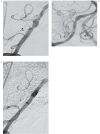Use of the pipeline embolization device to treat recently ruptured dissecting cerebral aneurysms
- PMID: 25207906
- PMCID: PMC4187439
- DOI: 10.15274/INR-2014-10042
Use of the pipeline embolization device to treat recently ruptured dissecting cerebral aneurysms
Abstract
The Pipeline embolization device (PED) is one of the flow-diverting stents approved for the treatment of unruptured large or wide-necked cerebral aneurysms in 2011(1). Its use has now been extended to the treatment of recently ruptured dissecting cerebral aneurysm, carotid pseudoaneurysm from radiation injury, and blister aneurysms(2,3). We aimed to evaluate the effectiveness of utilizing the PED as a primary treatment for ruptured dissecting intracranial aneurysms. A single center retrospective review was conducted for all patients primarily treated with PED for acute subarachnoid hemorrhage (SAH) from ruptured dissecting cerebral aneurysms between December 2010 and February 2013. Patients were followed up with CT angiogram (CTA) or digital subtraction angiogram (DSA). Eight patients with a total of eight dissecting aneurysms were identified. The mean duration from SAH to treatment was 2.5 days. Six of the aneurysms arose from vertebral arteries and two from the basilar artery. Immediate check-DSA confirmed satisfactory contrast stasis in all eight cases, and complete aneurysmal obliteration was achieved at six months. There were two (25%) procedure-related complications, but no major procedure-related complications, such as thromboembolic events or rebleeding from aneurysm were encountered. The PED is a feasible treatment option for ruptured dissecting cerebral aneurysms in acute phase. According to our experience, using PED as flow-diverters in acute SAH does not significantly increase the complication risks or mortality rate if the antiplatelet regime is carefully monitored. Future studies shall evaluate the optimal antiplatelet regimen for using the PED in the acute phase.
Keywords: VerifyNow assay; dissecting aneurysms; pipeline embolization device; subarachnoid hemorrhage.
Figures

Similar articles
-
Pipeline flow diversion of ruptured blister aneurysms of the supraclinoid carotid artery using a single-device strategy.Neurosurg Focus. 2017 Jun;42(6):E11. doi: 10.3171/2017.3.FOCUS1757. Neurosurg Focus. 2017. PMID: 28565992
-
Endovascular Treatment of Ruptured Vertebrobasilar Dissecting Aneurysms Using Flow Diversion Embolization Devices: Single-Institution Experience.World Neurosurg. 2018 Jan;109:e164-e169. doi: 10.1016/j.wneu.2017.09.125. Epub 2017 Oct 5. World Neurosurg. 2018. PMID: 28987840
-
Pipeline Embolization Device Flow Diversion for a Dissecting Ruptured Posterior Cerebral Artery Aneurysm in a Pediatric Patient.World Neurosurg. 2018 Sep;117:255-260. doi: 10.1016/j.wneu.2018.06.031. Epub 2018 Jun 15. World Neurosurg. 2018. PMID: 29909213
-
Expanding Indications for Flow Diverters: Ruptured Aneurysms, Blister Aneurysms, and Dissecting Aneurysms.Neurosurgery. 2020 Jan 1;86(Suppl 1):S96-S103. doi: 10.1093/neuros/nyz304. Neurosurgery. 2020. PMID: 31838529 Review.
-
Flow diversion with Pipeline Embolic Device as treatment of subarachnoid hemorrhage secondary to blister aneurysms: dual-center experience and review of the literature.J Neurointerv Surg. 2017 Jan;9(1):29-33. doi: 10.1136/neurintsurg-2016-012287. Epub 2016 Apr 13. J Neurointerv Surg. 2017. PMID: 27075485 Review.
Cited by
-
Treatment of Intracranial Vertebral Artery Dissecting Aneurysms Using Pipeline Embolization Devices : A Multicenter Cohort Study.Clin Neuroradiol. 2023 Dec;33(4):1105-1114. doi: 10.1007/s00062-023-01318-7. Epub 2023 Jun 28. Clin Neuroradiol. 2023. PMID: 37380901
-
Treatment of an acutely ruptured complex fusiform middle cerebral artery aneurysm with flow diverting stenting and adjunctive coil embolization.Neurosurg Focus Video. 2022 Oct 1;7(2):V5. doi: 10.3171/2022.7.FOCVID2249. eCollection 2022 Oct. Neurosurg Focus Video. 2022. PMID: 36425267 Free PMC article.
-
Patients with subarachnoid haemorrhage from vertebrobasilar dissection: treatment with stent-in-stent technique.Neuroradiology. 2015 Jun;57(6):605-14. doi: 10.1007/s00234-015-1505-9. Epub 2015 Mar 5. Neuroradiology. 2015. PMID: 25740790
-
Outcomes after Flow Diverter Treatment in Subarachnoid Hemorrhage: A Meta-Analysis and Development of a Clinical Prediction Model (OUTFLOW).Brain Sci. 2022 Mar 15;12(3):394. doi: 10.3390/brainsci12030394. Brain Sci. 2022. PMID: 35326350 Free PMC article. Review.
-
Clinical and angiographic outcomes in patients with intracranial aneurysms treated with the pipeline embolization device: intra-procedural technical difficulties, major morbidity, and neurological mortality decrease significantly with increased operator experience in device deployment and patient management.Neuroradiology. 2017 Dec;59(12):1291-1299. doi: 10.1007/s00234-017-1930-z. Epub 2017 Oct 6. Neuroradiology. 2017. PMID: 28986614
References
-
- Fischer S, Vajda Z, Aguilar Perez M, et al. Pipeline embolization device (PED) for neurovascular reconstruction: initial experience in the treatment of 101 intracranial aneurysms and dissections. Neuroradiology. 2012;54(4):369–382. doi: 10.1007/s00234-011-0948-x. - DOI - PMC - PubMed
-
- Martin AR, Cruz JP, Matouk CC, et al. The pipeline flow-diverting stent for exclusion of ruptured intracranial aneurysms with difficult morphologies. Neurosurgery. 2012;70(1 Suppl Operative):21–28. discussion 28. - PubMed
-
- Augsburger L, Farhat M, Reymond P, et al. Effect of flow diverter porosity on intraaneurysmal blood flow. Klin Neuroradiol. 2009;19(3):204–214. doi: 10.1007/s00062-009-9005-0. - DOI - PubMed
-
- Kallmes DF, Ding YH, Dai D, et al. A new endoluminal, flow-disrupting device for treatment of saccular aneurysms. Stroke. 2007;38(8):2346–2352. doi: 10.1161/STROKEAHA.106.479576. - DOI - PubMed
MeSH terms
LinkOut - more resources
Full Text Sources
Other Literature Sources
Medical

